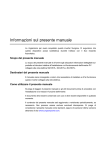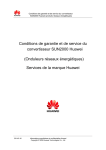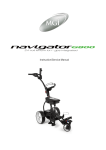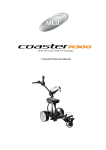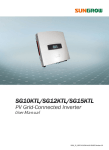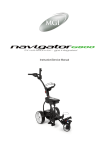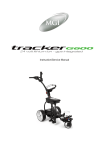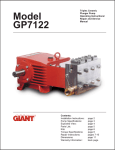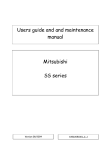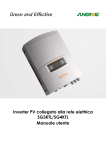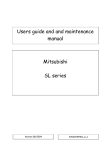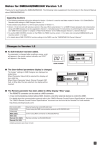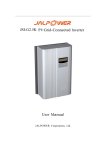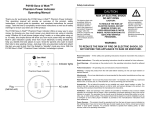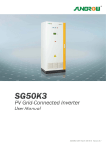Download About This Manual
Transcript
About This Manual Contents of this Manual This manual is applied to grid-connected inverters of JSI-10KTL, JSI-12KTL and JSI-15KTL. This manual provides detailed product introduction, installation guide, operation guide and maintenance guide. This document also provides very important safety instructions about installation, operation or maintenance. Target Reader The manual is provided to installation technicians and users. The tasks of installation and troubleshooting in this manual must only be performed by the qualified personnel. The tasks of menu operation and routine maintenance can be performed by the users. Retention of this Manual This document must be stored near installation site and must be available at all times. Symbols Used Important instructions contained in this manual should be followed during installation and maintenance of the inverter. And they will be highlighted by these symbols. 1 JSI-10KTL-12KTL-15KTL User Manual This symbol indicates a dangerous situation which, if not avoided, will cause death or severe injury. This symbol indicates a dangerous situation which, if not avoided, could result in death or severe injury. This symbol indicates a dangerous situation which, if not avoided, could cause minor or moderate injury. This symbol indicates a situation which can help the equipment optimal operation. Symbols on the body of the inverter: High Voltage! There exists lethal voltage. Please wait at least five minutes and then perform any work with the inverter after disconnecting the electrical connection of the inverter. Risk of Burning ! The surface will be very hot during running. Avoid touching the housing of equipment except LCD display panle and DC switch when it is working. 2 Contents About This Manual ................................................................................................... 1 Contents of this Manual.......................................................................................................................... 1 Target Reader......................................................................................................................................... 1 Retention of this Manual ........................................................................................................................ 1 Symbols Used ........................................................................................................................................ 1 1 Safety Instructions ................................................................................................. 1 2 Product Overview ................................................................................................... 5 2.1 Intended Use .................................................................................................................................... 6 2.2 Main Circuit ....................................................................................................................................... 7 2.3 Features of JSI-10K-12K-15KTL Inverters ....................................................................................... 7 2.4 Product Description .......................................................................................................................... 8 3 Installation ............................................................................................................... 9 3.1 Unpacking and Inspection .............................................................................................................. 10 3.2 Packing List .................................................................................................................................... 10 3.3 Nameplate....................................................................................................................................... 10 3.4 Moving Inverter ................................................................................................................................11 3.5 The Requirements of Installation Site ..............................................................................................11 3.6 Dimensions of Inverter .................................................................................................................... 14 3.7 Installation Procedure ..................................................................................................................... 15 4 Electrical Connection ........................................................................................... 19 4.1 General Safety ................................................................................................................................ 20 4.2 Overview of Electrical Installation ................................................................................................... 21 4.3 Terminals Description ..................................................................................................................... 22 4.4 Specification of Cables ................................................................................................................... 23 4.5 Connecting inverter to PV Arrays ................................................................................................... 24 4.5.1 Safety ..................................................................................................................................... 24 4.5.2 Assembling DC Cable to Connector....................................................................................... 25 4.5.3 Wiring Procedure.................................................................................................................... 27 4.6 Connecting Inverter to AC Grid ....................................................................................................... 28 4.7 Grounding the Inverter .................................................................................................................... 31 I JSI10KTL/12KTL/15KTL User Manual 4.8 Connecting RS485 Cable ............................................................................................................... 32 4.8.1 Installing Monitoring System .................................................................................................. 32 4.8.2 Assembling RS485 Cable to Connector ................................................................................. 33 4.8.3 Connecting RS485 Cable ....................................................................................................... 34 5 LCD Panel and DC Switch ................................................................................. 37 5.1 LCD Panel....................................................................................................................................... 38 5.2 LED Indicator .................................................................................................................................. 38 5.3 Buttons ............................................................................................................................................ 38 5.4 LCD Screen .................................................................................................................................... 39 5.5 Operation mode .............................................................................................................................. 40 5.6 DC Switch ....................................................................................................................................... 41 6 Commissioning ..................................................................................................... 43 7 Menu Operation ................................................................................................... 45 7.1 Overview of Menu ........................................................................................................................... 46 7.2 Default Menu .................................................................................................................................. 47 7.3 Adjust Contrast ............................................................................................................................... 47 7.4 Start Inverter ................................................................................................................................... 48 7.5 Stop Inverter ................................................................................................................................... 49 7.6 Monitor Running Information .......................................................................................................... 50 7.7 Monitor Running Record ................................................................................................................. 51 7.8 Monitor Fault Record ...................................................................................................................... 52 7.9 Parameters Setting ......................................................................................................................... 54 7.9.1 Set Language ......................................................................................................................... 54 7.9.2 Set Time ................................................................................................................................. 55 7.9.3 Setting Total Generated Power Adjustment ........................................................................... 56 7.9.4 Load Default ........................................................................................................................... 57 7.9.5 Set Running Parameter .......................................................................................................... 58 7.9.6 Set Protecting Parameter ....................................................................................................... 59 7.9.7 Set Communication Parameter .............................................................................................. 61 8 Troubleshooting and Maintenance................................................................... 63 8.1 Troubleshooting .............................................................................................................................. 64 8.1.1 Troubleshooting of LED Indicator ........................................................................................... 64 8.1.2 Troubleshooting of faults in LCD Screen................................................................................ 64 8.2 Maintenance ................................................................................................................................... 66 8.2.1 Clean Fan ............................................................................................................................... 66 8.2.2 Replace Fan ........................................................................................................................... 67 II 8.2.3 Clean Air Inlet and Outlet ....................................................................................................... 67 9 Technical Specification ....................................................................................... 69 10 Appendix .............................................................................................................. 73 10.1 Exclusion of Liability...................................................................................................................... 74 10.2 Contact Us .................................................................................................................................... 75 III 1 Safety Instructions About this Chapter This chapter describes very important safety instructions. Please read “Safety Instructions” carefully before any work with the inverter. 1 JSI10KTL-12KTL-15KTL User Manual The inverter is designed and tested according to international safety requirements. But as all electrical and electronic equipments, certain precautions should be observed during installing, operating and maintaining. Incorrect operation or work performed incorrectly can result in damage to: The life and well-being of the operator or the third party The inverter and other properties that belong to the operator or the third party Therefore in order to reduce risk of injury and ensure the safety of the inverter, you must carefully read and follow all instructions, cautions and warnings. First disconnect the inverter from utility grid! Even when the inverter is disconnected, lethal voltages still exists within the inverter. Before any maintenance work, you should wait for at least five minutes and then perform work. All tasks of installation and maintenance must only be performed by qualified personnel. They are trained specially. They have read this manual, and comprehend all operation methods and related safety instructions. All electrical installations must be in accordance with local and national electrical codes. 2 Safety Instructions Only after receiving prior approval from the utility company and qualified personnel installing the inverter, you can connect the inverter to the utility grid. All cables must be firmly attached, undamaged, properly insulated and adequately dimensioned. When choosing the installation site, this ingredient to ensure that there is no electromagnetic interference with other electrical and electronic equipments must be taken into consideration. Risk of damage to the inverter due to improper modification. Never modify the inverter or other components of the inverter. Otherwise it will lead to loss of any and all warranty right. Any malfunction that can impair inverter safety must be repaired immediately before the inverter is switched on again. Please contact your local authorized personnel if any maintenance is required. 3 JSI10KTL-12KTL-15KTL User Manual Electrostatic discharge can damage the inverter. During replacing or installing the inner components, the technical personnel should take appropriate protective measures such as electrostatic bracelet. All safety instructions and warning labels on the inverter body; Must be clearly visible Must not be removed, covered, pasted These regulations should also be followed: The regulations related to the electricity fed into the grid The safety instructions related to the PV arrays 4 2 Product Overview About this Chapter This chapter introduces intended use, main circuits, features and its constituent parts. 5 JSI10KTL-12KTL-15KTL User Manual 2.1 Intended Use Thank you for purchasing an inverter from Jalpower Company. JSI10KTL, JSI12KTL and JSI15KTL serial inverters are grid-connected, transformerless, robust and high conversion efficiency. The inverter converts DC power generated from the PV arrays into stable AC current, and then feeds this into the utility grid. The grid is three-phase four-wire type or three-phase five-wire type. Inverter is crucial unit in the small-scaled PV power system. An example about intended use of this inverter is show in Fig 2-1. A B C Fig 2-1 Inverter Applied in the PV Power System Item Description A PV Arrays B Inverter C Metering Device D Utility Grid Any other or additional use is not permitted except the intended use. The inverter must only be connected to public utility grid. 6 D Installation If output of inverter is connected to local loads (household appliance, lights, motor loads, etc.), the inverter will stop working. 2.2 Main Circuit F o l l o w i n g shows the main circuit of JSI15KTL----a transformerless grid-connected inverter. JSI10KTL and JSI12KTL have the similar main circuit. There are two MPP trackers designed for input. The boost stage levels up the input DC voltage to a desirable value for the inverter. Then an IGBT three-level inverter circuit converts the DC power to AC power. This AC power is fed into the utility grid via AC EMI filter. DC Switch DC1 DC EMI Filter Boost Circuit + DC2 Relay + L1 IGBT Threelevel Inverter Circuit AC EMI Filter Boost Circuit DC EMI Filter AC EMI Filter L2 Grid L3 N Ground Fig 2-2 Main Circuit Diagram of Inverter 2.3 Features of JSI-10K-12K-15KTL The following are technical features of JSI10K-12K-15KTL: Power reduction(100%,60%,30%,0%) meets German EEG requirements Reactive power control with power factor from 0.9 lagging to 0.9 leading Max efficiency at 98% Wide DC input voltage range with max. 1000V 7 JSI10KTL-12KTL-15KTL User Manual Double MPP trackers for different installation inclinations. Weather-proof design(IP65) for harshest working enviornment High reliability with full protective functions Compact design with high quality aluminium housing. Water-proof direct plug-in termimals TUV certification, KEMA DK5940 2.4 Product Description 1 2 3 6 5 4 Fig 2-3 Product Description Item Name Description 1 Display panel Running data and configuration parameters are displayed in the LCD screen. Detailed information will be introduced in following. 2 Air outlet Hot air generated during running process is exhausted via the air outlet. 3 Handles The handles are designed for transport and install the unit. 4 Air inlet Entrance of cool air. 5 DC switch In normal condition it is in “ON” state. It can be turned off manually in any emergency condition. And then the inverter will stop running. 6 Connection terminals They are DC input terminals, AC output terminal and RS485 communication terminal. 8 3 Installation About this Chapter This chapter proposes how to choose installation site and gives step-by-step procedures to install the inverter onto the wall. And related safety instructions are also included. 9 JSI-10KTL-12KTL-15KTL User 3.1 Unpacking and Inspection The unit is thoroughly tested and inspected strictly before delivery. Although sturdy package is adopted, damage may still happen during the shipping. The first thing you should do is to check the packing box when receiving the inverter unit. Meanwhile please check the completeness of the delivery contents. If damage to the packing box is visible, or if you find that the inverter unit is damaged after unpacking, please notify the shipping company and Jalpower Company. If a related photo is supplied, you will get faster and better service. 3.2 Packing List Inverter unit Backplate Fastener(M10*85) DC positive connectors*7 DC negative connector*7 RS485 connector User manual Qualification certificate Warranty card Product test report Packing list Delivery inspection report 3.3 Nameplate Nameplate is shown on the package box and on the side of the inverter body. You can check whether the serial number and the type of inverter is right, as well as other parameters information. 10 Installation Fig 3-1 Nameplate of Inverter 3.4 Moving Inverter Risk of injury due to ignoring the weight of the inverter. The inverter is about 50kg. Proper device is needed or with the help of other people to avoid damage to the inverter when installing or moving. Fig 3-2 Moving the Inverter 3.5 The Requirements of Installation Site This section provides guidelines to help you choose the best installation site, suggestions to make sure the unit optimal operation, the warnings to avoid damage to the unit or the operator. 11 JSI10KTL-12KTL-15KTL User Manual When choosing the installation site, Ensure that there is no electromagnetic interference with other electrical and electronic equipments. Requirements: The wall selected should be strong enough to hold the weight of the inverter. Do not install the unit in the direct sunlight or in an enclosure exposed to the direct sunlight. Exposure to the sun may cause additional internal heating. This can result in reducing output power. The chosen installation site maintains ambient temperature range from -25°C to 60°C. When the temperature exceeds 45°C, the output power will reduce. The humidity of chosen installation site never exceeds 95%.Moisture may result in corrosion to the lid and damage to the inner electronic components. 12 Installation Do not install the inverter unit on flammable construction materials or on the building that contains flammable materials. Take enough space for heat dissipation into consideration when choosing the site. The following suggestive value for the space to keep clear around the inverter should be adopted. Min. clearance suggested Left 30cm Right 30cm Top 10cm Bottom 50cm Front 20cm 50cm 10cm Orientation Install the inverter at eye level. Meanwhile some space at the bottom needs to be kept for electrical connection. Do not install the inverter in this site where the children can reach. The housing of the inverter will be very hot. It is risk of burning. Do not install the inverter in living area. Noise can be produced during running of the inverter, which will affect your daily life. 13 JSI10KTL-12KTL-15KTL User Manual 3.6 Dimensions of Inverter Fig 3-3 Outline Dimensions of Inverter Item Description W Width H Height D Depth Table 3-1 Dimension Value Type W(cm) H(cm) D(cm) Net weight(kg) JSI-10KTL 64.8 69.5 23.2 45 JSI-12KTL 64.8 69.5 23.2 51 JSI-15KTL 64.8 69.5 23.2 55 14 Installation 3.7 Installation Procedure There is a backplate and fasteners supplied to install the inverter. If you don‟t want to use the supplied backplate, you can drill holes refer to its dimension below. 305 10 33 7-12*9 394.9 151.5 37 120 325 Fig 3-4 Dimensions of Backplate In the following pages we will introduce the installation procedures using the provided backplate and fasteners. 15 JSI10KTL-12KTL-15KTL User Manual INSTALLATION PROCEDURE: Step 1: Get the supplied backplate and fasteners from the package. Step 2: Choose the best installation site according to above requirements. Place the backplate onto the chosen wall and adjust it until it is in a horizontal position. Step 3: Mark the positions to drill holes using the backplate as the template. Step 4: Drill seven holes at the marks you have made. The size of the hole is illustrated in the below picture. D C A B Item Description A The depth of hole B The diameter of hole C Hole D Wall Fig 3-5 Dimensions of Holes Specification of expansion bolt M10*85 Hole size(mm) Depth(A) Diameter(B) 65 14.5 In order to avoid electrical shock or other injury, inspect existing electronic or plumbing installations before drilling holes. 16 Installation Step 5: Insert the expansion bolts through the holes on the backplate and into the holes you have drilled. Step 6: Fasten the backplate against the wall via washer, sping washer and hexagonal nut. A B C D E F Fig 3-6 Demo Diagram of Backplate Fastening Process Item Description A Wall B Backplate C Expansion bolts D Washer E Spring washer F Hexagonal nut Risk of damage to expansion bolt due to over-tightening the nut. 17 JSI10KTL-12KTL-15KTL User Manual Step 7: Now you can hang the inverter onto the backplate as Fig 3-7 shows. Make sure the two recesses on the back of the inverter fit perfectly together with the backplate. Fig 3-7 Installing the Inverter 18 4 Electrical Connection About this Chapter This chapter proposes step-by-step procedures to perform electrical connection and related safety instructions. 19 JSI10KTL-12KTL-15KTL User Manual 4.1 General Safety Improper operation during the wiring process can cause fatal injury to operator or unrecoverable damage to the inverter. Only qualified personnel can perform the wiring work. All electrical installations must be in accordance with local and national electrical codes. Only after receiving prior approval from the utility company and qualified personnel installing the inverter, you can connect the inverter to the utility grid. All cables must be firmly attached, undamaged, properly insulated and adequately dimensioned. These regulations should also be followed: The regulations related to the electricity fed into the grid The safety instructions related to the PV arrays 20 Electrical Connection 4.2 Overview of Electrical Installation Electrical connection of the inverter includes DC connection, AC connection and communication connection. F G E AC RS48 DC2 DC1 ON A OFF B C D Fig 4-1 Electrical Connection Diagram Item Description Remark A Connection area of inverter It is located at the bottom of the inverter B AC circuit breaker User equips this device C Grid -------- D PV arrays -------- 21 JSI10KTL-12KTL-15KTL User Manual Item Description Remark E RS485-RS232 converter User can order it from Jalpower F Remote PC User equips this device G SunInfoTM logger User can order it from Jalpower The dashed line in the above diagram indicates that there is another way of communication connection. See “4.8 Connecting RS485 Cable”. 4.3 Terminals Description All electrical terminals are all located at the bottom of unit. Fig 4-2 shows the connection area. Enough space should be kept for electrical connection at the bottom of the inverter when choosing the installation site. AC ON RS485 OFF DC2 A DC1 B C Fig 4-2 Terminals Description Item Description A AC connector B RS485 connector C DC connectors D DC switch 22 D Electrical Connection 4.4 Specification of Cables DC cables and RS485 cables of PV power system are equipped with water-proof direct plug-in connector. You„ll find these connectors in the package. For electrical connection in PV power system, specification of all cables used should meet following requirements. Table 4-1 Specification of cables Items Num Min. cross area Max. cross area Recommended value (mm2) (mm2) (mm2) DC positive cable 6 4 6 4 DC negative cable 6 4 6 4 AC cable L1 1 6 8 6 L2 1 6 8 6 L3 1 6 8 6 N 1 6 8 6 GND 1 6 8 6 2 0.75 2 0.75 RS485 cable 23 JSI10KTL-12KTL-15KTL User Manual 4.5 Connecting inverter to PV Arrays 4.5.1 Safety As input of the inverter in the PV power system, PV Arrays‟ features should be paid attention to. Please refer to PV module‟s data sheet. When designing PV arrays, following requirements should be met. Lethal voltage exists! Do cover the PV arrays. Exposed to sunlight, PV arrays will output lethal voltage. Risk of damage to the inverter. Make sure that the maximum open voltage of each string is within DC input voltage range of the inverter. Voltage over 1000V can damage to the inverter. Risk of damage to the inverter. Make sure that the maximum short current of each string is less than maximum input current. Please refer to chapter “9 Technical Specification”. For each input zone, PV arrays should respectively have a homogenous structure, including the same type, the same number, identical tilt and identical orientation. 24 Electrical Connection 4.5.2 Assembling DC Cable to Connector All DC cables are equiped with water-proof direct plug-in connectors, which mate with DC conectors at input zones. DC positive assembling procedure: Step 1: Unscrew the water-proof terminal in the following direction. Step 2: Insert appropriately sized DC cable through water-proof terminal. Step 3: Strip off insulation layer of DC cable. The length of strip insulation is approximate 8mm. 8mm Step 4: Crimp cable core with hand crimping plier. Step 5: Plug cable gland into connector housing until there is “Ka” voice. Step 6: Tighten the water-proof terminal in opposite direction. DC negative assembling procedure: Step 1: Unscrew the water-proof terminal in the following direction. 25 - JSI10KTL-12KTL-15KTL User Manual Step 2: Insert appropriately sized DC cable through water-proof terminal. Step 3: Strip off insulation layer of DC cable. The length of strip insulation is approximate 8mm. 8mm Step 4: Crimp cable core with hand crimping plier. - Step 5: Plug cable gland into connector housing until there is “pa” voice. - Step 6: Tighten the water-proof terminal in opposite direction. The positve and negative connectors are marked with polority symbols and colored cable. Red cable represents DC positive conector and blue one represents negative. If positive and negative cable have been assembled, it is easy to plug these connectors to the corresponding connectors at the bottom of inverter. When connectting connectors, they will be correctly locked in the mating place. Release the locking part by pressing on the ribbling of the locking hooks and pull them outwords. 26 - Electrical Connection 4.5.3 Wiring Procedure There are DC1 input zone and DC2 input zone, each with its own MPP tracker, as Fig 4-2 shows. Wiring Procedure: Step 1: Assemble DC cable to connector at the inverter side. See “4.5.2 Assembling DC Cable to Connector”. Step 2: Manually rotate DC switch at the bottom of the inverter to “OFF” position. Step 3: Check connection cable of one PV array string for correct polarity and that the maximum input voltage does not exceed 1000V. Step 4: Plug DC positive and negative connector into corresponding terminasl. If there is a “pa” sound, it means DC connector has attached to terminals. It is not permitted for one input string to connect in the following way. Step 4: Connect other strings in the same procedure. 27 JSI10KTL-12KTL-15KTL User Manual 4.6 Connecting Inverter to AC Grid Only after receiving prior approval from the utility company you can connect the inverter to local utility grid. The grid should meet these following requirements. Otherwise the inverter will not work. Grid Voltage 3*310V~3*450V Grid Frequency 47~51.5Hz/57~61.5Hz AC Wiring Procedure: Step 1: Make sure that the AC circuit breaker is switched off. Step 2: Dismantle the board with screwdriver. Step 3: Unscrew the waterproof terminal in the direction shown in the following picture. Step 2 Step 3 Step 4: Insert the cables via the holes of the AC terminals. Step 5: Pull the cable from the other side. Step 6: Strip off insulation layer of all AC cables. The length of strip insulation is approximate 10mm. 28 Electrical Connection Step 6 Step 5 Step 4 Step 7: Press down the two red latches of inner AC connector. Step 8: Pull inner AC connector outside. Step 7 Step 8 Step 9: Connect all cables to the terminal outside the inverter. Step 9 29 JSI10KTL-12KTL-15KTL User Manual Step 10: Plug the section above into the fixed terminal inside the inverter. Step 11: Fasten the board. Step 12: Screw the waterproof terminals in the direction shown in the following picture. Step 10 Step 11 Step 12 Step 13: Connect AC circuit breaker to grid. 30 Electrical Connection 4.7 Grounding the Inverter Because of the transformless design of the inverter, DC positive pole and DC negative pole are not permitted to be grounded. Otherwise the inverter can stop running. All non-current carrying exposed metal parts of equipment and other enclosure in the PV power system should be grounded (e.g., PV arrays, DC circuit breaker and inverter). For AC side, it is better to use a continuous irreversibly appropriately sized conductor bare to ground inverter. Inverter AC air switch Grid AC grounding electrode Fig 4-3 AC Side of Inverter Grounding 31 JSI10KTL-12KTL-15KTL User Manual 4.8 Connecting RS485 Cable 4.8.1 Installing Monitoring System The inverter provides RS485 interface to communicate with remote PC or logger. User can monitor the state of the inverter, observe current running information and history record via this interface. There are three methods provided for user to install the monitoring system. Data logger Inverter Data logger Fig 4-4 Collecting Data with SunInfo Data Logger Data logger+ PC Inverter Data logger PC Fig 4-5 Collecting Data with SunInfo Data Logger and PC PC Inverter RS485-RS232 Converter PC Fig 4-6 Collecting Data with PC and RS485/RS232 Converter SunInfoTM logger and RS232-RS485 converter are optional parts and can be orded from Jalpower. 32 Electrical Connection 4.8.2 Assembling RS485 Cable to Connector All RS485 cables are equiped with water-proof direct plug-in connectors, which can mate with RS485 conectors at the bottom of inverter. Assembling procedure: Step 1: Dismantle RS485 connector in the same way of DC connector. Step 2: Connect appropriately sized cables to pin1 and pin3, as shown in the following picture. 3 1 Pins are marked with symbols at the other side. Step 3: Tighten its water-proof terminal. 33 JSI10KTL-12KTL-15KTL User Manual 4.8.3 Connecting RS485 Cable RS485 is communication standard for bidirectional transmission of data between one or more inverters and a PC or a data logger. If there is more than one inverter to communicate with a PC or a data logger, it is crucial to configure communication parameters of each inverter. See “7.9.7 Set Communication Parameter”. RS485 bus’ requirements to ensure quality of communication: RS485 bus should be shielding twist-pair Shielding layer of RS485 bus should be single-point grounding, grid indicating shielding layer in following pictures Data logger Inverter 1 Inverter 2 Inverter n(n<30) SunInfoTM Logger A B A A B B A1 120Ω 120 B1 RS485 Bus Wiring procedure: Step 1: A resistance with 120Ω is connected at the initating terminal of RS485 bus. Step 2: Plug the connector of RS485 cable into corresponding RS485 terminal of Inverter 1. Step 3: The two lines of the other end of RS485 cable, labled A and B, connected to corresponding lines of RS485 bus, as the above diagram. Step 4: Connect other inverters to RS485 bus in the same way. Step 5: Connect the end of RS485 bus to A1 port and B1 port of SunInfoTM logger. 34 Electrical Connection Data logger+ PC Inverter 1 Inverter n(n<30) Inverter 2 PC TM SunInfo B A A A B Logger B A1 120Ω 54 3 21 9 87 6 B1 RS485 Bus RS323 Bus Wiring procedure: Step 1: A resistance with 120Ω is connected at the initating terminal of RS485 bus. Step 2: Plug the connector of RS485 cable into corresponding RS485 terminal of Inverter 1. Step 3: The two lines of the other end of RS485 cable, labled A and B, connected to corresponding lines of RS485 bus, as the above diagram. Step 4: Connect other inverters to RS485 bus in the same way. Step 5: Connect the end of RS485 bus to A1 port and B1 port of SunInfoTM logger. Step 6: Connect RS232 port of SunInfoTM logger to RS232 port of PC. PC Inverter 1 Inverter 2 Inverter n(n<30) PC RS485-RS232 Converter A B A B A B RX+ RXTX+ TX- 120 Ω RS485 Bus 54 3 21 9 87 6 RS232 Bus Wiring procedure: Step 1: A resistance with 120Ω is connected at the initating terminal of RS485 bus. Step 2: Plug the connector of RS485 cable into corresponding RS485 terminal of Inverter 1. 35 JSI10KTL-12KTL-15KTL User Manual Step 3: The two lines of the other end of RS485 cable, labled A and B, connected to corresponding lines of RS485 bus, as the above diagram. Step 4: Connect other inverters to RS485 bus in the same way. Step 5: At the end of RS485 bus, connect RS485 A cable to “RX+” port of RS232-RS485 converter and connect RS485 B cable to “TX-” port of RS232-RS485 converter. Step 6: Connect RS232 port of RS232-RS485 converter to RS232 port of PC. 36 5 LCD Panel and DC Switch About this Chapter This chapter proposes parts that user can operate——LCD panel and DC Switch. 37 JSI10KTL-12KTL-15KTL User Manual 5.1 LCD Panel LCD panel comprise LED indicators, buttons and LCD screen. Leds indicate the current state of the inverter. The current running information and history information can be seen in the LCD screen with operating the buttons. P(%) Power 15.000kW 100 RUN 80 E-day 125.6kWh E-tot 497600 kWh State Run 60 40 20 FAULT t 6 8 14 20 2009/11/18 18:35 Fig 5-1 LCD Panel 5.2 LED Indicator There are two LED indicators, “RUN” and “FAULT” respectively. User can observe these leds to get the current state. Table 5-1 LED Indicator Description Name State Description “RUN” On Inverter is running. Off Inverter is not running. On A malfunction occurs Off A malfunction doesn‟t occur. “FAULT” 5.3 Buttons There are two buttons on the panel as Fig 5-1 shows. They are “ 38 ” and “ ”. LCD Panel and DC Switch Table 5-2 Description of Button Function Name “ “ ” ” Operation Description Press less than two seconds Move to last row, or move to previous page, or increase setting value. Press more than two seconds Return to parent menu. Press less than two seconds Move to next row, or move to previous page, or increase setting value. Press more than two seconds Select menu item or confirm setting. When the two buttons “ ” and “ ” are pressed more than three seconds, inverter will stop running and enter into the “Key-stop” state. The background illumination of LCD screen will go out to save power if there is not button operation in two minutes. You can activate again by pressing any button. 5.4 LCD Screen LCD screen can display the current state of inverter, current running information, history information and setting parameters menu. They can be accomplished with button operation, see “7 Menu Operation”. LCD screen and buttons provide a good human-computer interaction interface. 39 JSI10KTL-12KTL-15KTL User Manual In its default interface, user can observe operation mode or fault type of inverter. P(%) 100 80 60 P-ac 15.000kW E-day 125.60kWh E-total 40 20 t 8 14 State 497600 kWh Run 20 2009/11/18 18:35 Fig 5-2 Default Interface If there is no button operation in three minutes, it will go back to default menu. 5.5 Operation mode This chapter illustrates the operation modes of inverter. Stop The inverter is shut down. Stand-by Stand-by mode is entered for insufficient input power (Ppv≈0 for 3 minutes). In stand-by mode the inverter will wait until the DC voltage recovers to 220V in standby time (set by user, see”7.9.5 Set Running Parameter”). Startup The inverter is initializing and synchronizing with the grid. Run After being energized, the inverter tracks the PV arrays‟ maximum power point (MPP) and converts the DC power to AC power. This mode is the normal operational mode. Fault If a fault occurs during running, the inverter will automatically stop operation, disconnect the AC relay and display the fault type in the LCD panel with the “Fault” LED lit. Once the fault is removed inrecovery time (set by user, see”7.9.5 Set Running Parameter”), the inverter will automatically resume running. Key-Stop The inverter will stop operation by manual stop through LCD menu; this condition needs manual restart through LCD menu. 40 LCD Panel and DC Switch Fault is cleared Fault A fault occurs T=Recover time 30~300s Stop Standby T=Standby time 10~255s Perform command “Stop” Inverter is energized T=40s Start Keystop Run Perform command “Stop” After running normally Fig 5-3 Mode Transition Explanation Diagram If “ ” and “ ” button are long pressed, inverter will enter into the “Key-stop” mode. 5.6 DC Switch DC switch is designed for stopping the inverter. Inverter work automatically if input and output meet the requirements. If you want to interrupt its running or if a malfunction occurs, it can be rotated to “OFF” state. And then the inverter will stop running. 41 JSI10KTL-12KTL-15KTL User Manual If you want to restart the inverter, rotate DC switch to “ON” position again. 42 6 Commissioning About this Chapter This chapter demonstrates how to check before commissioning and operation procedures. 43 JSI10KTL-12KTL-15KTL User Manual Verify before commissioning Number Item Remark 1 Verify whether inverter is fastened onto the wall. See “1”. 2 Check whether all cables are undamaged, properly insulated and adequately dimensioned. See ” 4.4 Specification of Cables”. 3 Check whether all cables are firmly attached and correctly. See “4.5 Connecting inverter to PV Arrays” to “4.8 Connecting RS485 Cable” Commissioning Procedure: Step 1: Make sure all items above meet demands. Step 2: Switch off external AC circuit breaker. Step 3: Rotate DC switch to “ON” position. After external circuit breaker is closed in the PV power system: PV arrays initialize and supply DC power to inverter; When DC voltage exceeds 250V, DC Bus starts to charge; Inverter verify whether grid conditions are OK; If the conditions are OK, inverter feeds AC power to grid and enters into the running state. Step 4: Observe state of LED indicators and LCD screen. If inverter’s commissioning fails, “FAULT” indicator will be lit. And “ the LCD screen will display type of malfunction. State ” in In this case malfunction must be removed and then repeat step1 to step 4. If inverter„s commissioning succeeds, “RUN” indicator will be lit. If inverter„s commissioning succeeds, “ 44 State ” in the LCD screen will display “RUN”. 7 Menu Operation About this Chapter This chapter shows all menu operations. User can know how to check the state of the inverter, current running information and history information. And how to set the parameters of the inverter is also included. 45 E-day 15.6kWh Temp 49.5℃ P-in 9928W R U-PV1 380.0V 220.0V P-PV1 P-outS 9960W U-PV2 380.0V 220.0V T 221.0V E-total I-PV2 497600kWh 20.3A 20.3A 68.0A 68.0A 29760kg CO2-reduce P(%) P-PV2 7714W 7714W Power Curve 42W 42W 09/11/18 E-month 10 3750kWh 0 50.6Hz 50.1Hz 8 49.9Hz H-tot 620.3A 0 40 Min-day 486min 20 0 0 8 14 20 68.0A 42W t P 1/2 Run-record T[2] Long press 2009/11/17 (50) 2009/11/16 (32) Contrast-adj 50% P24/50 2009/11/18 E-day 125.6kWh 18:35 P-ac Long press 15.000kW P24/50 2009/11/18 18:35 300.4V 497600kW I-dc 13.6A E-total Temp 49.5℃ V-grid 220.0V I-grid 18.2A State F-grid 50.0Hz Run V-dc Language[0] Run-record Long press Long press Fault-record Long press Long press P(%) 100 80 P-ac 15.000kW E-day 125.60kWh 60 40 20 t 8 14 E-total 497600 kWh State Run Long press P 1/1 Fault-rec T[2] 1> 2009/11/05 09:15:59 Samp-flt 0001 2> 2009/11/05 09:15:59 Vac-high 451V Run-inform His-inform Start/Stop Set-param Long press 0: Spanish 2: Chinese 1: Italy 3: English 4: German 5: French 6: Japanese 7: Korea Time Date: 09/11/18 Time:18:35:55 Long press 20 2009/11/18 18:35 Start Confirm ? Long press Start Language Time Energy-adj Load default Long press Stop Long press Energy-adj +0000 kWh Stop Confirm? Long press Long press Standby time Recover time Limit -p 010s 030s 100% Long press Long press Load default Password: 0000 Set-param Password: 0000 Long press Long press Sys-param Run-param Pro-param Com-param 7.1 Overview of Menu JSI10KTL-12KTL-15KTL User Manual Long press Vgrid-max Vgrid-min Fgrid-max Fgrid-min 450V 310V 50.2Hz 47.5Hz Com-param Long press Address: 001 Please wait! 46 I-PV1 Fig 7-1 Menu Tree-English Long press Menu Operation 7.2 Default Menu When inverter is energized, LCD screen will display the default menu. P(%) 100 80 60 P-ac 15.000kW E-day 125.60kWh E-total 40 20 t 8 14 State 1. In the default menu, LCD screen displays basic information. 497600 kWh Run 20 2009/11/18 18:35 There are also current date and time. See “7.9.2 Set Time” to adjust the current time 7.3 Adjust Contrast 1. Long press button “ P(%) 100 80 P-ac 15.000kW E-day 125.60kWh 60 E-total 40 20 t 8 14 State ” to enter into the “Contrast-adj” menu in the default menu. 497600 kWh Run 20 2009/11/18 18:35 2. Short Press button “ contrast value. Contrast-adj 50% ” or “ ” to set 1 is the minimum value and 100 is the maximum. 47 JSI-10KTL-12KTL-15KTL User Manual 7.4 Start Inverter If conditions of DC side and AC side meet demands, or if malfunction is solved, the inverter will start to run automatically. If you perform command “Stop” and want to restart again, it is needed to perform command “Start”. P(%) 100 80 P-ac 15.000kW E-day 125.60kWh 60 497600 kWh E-total 40 20 t 8 14 1. Long press button “ ” to enter into the main control-menu in the default menu. State Run 20 2009/11/18 18:35 2. Short press button “ arrow to “Start/Stop”. Run-inform His-inform Start/Stop Set-param ” to move 3. And then long press button “ to enter into its submenu. 4. Short press button ” arrow to “Start”. Start Stop ” to move 5 And then long press button “ to enter into the submenu. 6 Long press button “ “Start” command. Start Confirm ? 48 ” ” ” to confirm Menu Operation 7.5 Stop Inverter “Stop” command will switch off AC relay. It is needed to perform “Start” command to restart the inverter. P(%) 100 80 P-ac 15.000kW E-day 125.60kWh 60 497600 kWh E-total 40 20 t 8 14 1. Long press button “ ” to enter into the main control-menu in the default menu. State Run 20 2009/11/18 18:35 2. Short press button ” arrow to “Start/Stop”. Run-inform His-inform Start/Stop Set-param ” to move 3. And then long press button “ to enter into its submenu. 4. Short press button ” arrow to “Stop”. Start Stop ” to move 5. And then long press button “ to enter into its submenu. 6. Long press button “ confirm “Start” command. Stop Confirm ? 49 ” ” ” to JSI10KTL-12KTL-15KTL User Manual 7.6 Monitor Running Information P(%) 100 80 P-ac 15.000kW E-day 125.60kWh 60 497600 kWh E-total 40 20 State t 8 14 1. Long press button “ ” to enter into the main control-menu in the default menu. Run 20 2009/11/18 18:35 2. Short press button ” ” to move arrow to “Run-inform”. Run-inform His-inform Start/Stop Set-param E-day 125.6kWh Temp 49.5℃ 3. And then long press button “ 4. Short Press button “ P-in 9928W P-out 9960W U-PV1 380.0V U-PV2 380.0V I-PV1 20.3A I-PV2 20.3A P-PV1 7714W P-PV2 7714W R S T 220.0V 220.0V 68.0A 68.0A 68.0A 42W 42W 42W 50.6Hz 50.1Hz 49.9Hz E-total 221.0V 497600kWh CO2-reduce 29760kg E-month 3750kWh H-tot 20.3A Min-day 486min P(%) 100 80 60 40 20 0 Power Curve 09/11/18 t 8 14 ” to enter into the submenu. 20 50 “ ” to turn pages. ” or Menu Operation 7.7 Monitor Running Record P(%) 100 80 P-ac 15.000kW E-day 125.60kWh 60 497600 kWh E-total 40 20 t 8 14 1. Long press button “ ” to enter into the main control-menu in the default menu. State Run 20 2009/11/18 18:35 2. Short press button” ” to move arrow to “His-inform”. Run-inform His-inform Start/Stop Set-param 3. And then long press button “ Run-record 4. Short press button “ ” to move arrow to “Run-record”. Fault-record 5. And then long press button “ P 1/2 ” to enter into its submenu. Run-record T[2] 2009/11/17 (50) 2009/11/16 (32) ” to enter into its submenu. 6. Short press button ” ” to move arrow to time you want to verify. 7. And then long press button “ 8. Short Press button “ P24/50 2009/11/18 E-day 125.6kWh P-ac 15.000kW V-dc 300.4V I-dc 13.6A V-grid 220.0V I-grid 18.2A F-grid 50.0Hz P24/50 2009/11/18 E-total 497600kW Temp 49.5℃ State Run ” to enter into its submenu. 18:35 “ 18:35 51 ” to turn pages. ” or JSI10KTL-12KTL-15KTL User Manual 7.8 Monitor Fault Record P(%) 100 80 P-ac 15.000kW E-day 125.60kWh 60 497600 kWh E-total 40 20 t 8 14 1. Long press button “ ” to enter into the main control-menu in the default menu. State Run 20 2009/11/18 18:35 2. Short press button ” arrow to “His-inform”. Run-inform His-inform Start/Stop Set-param ” to move 3. And then long press button “ enter into the submenu. ” to Run-record 4. Short press button ” ” to move arrow to “Fault-record”. Fault-record 5. And then long press button “ P 1/1 Fault-rec T[2] 1> 2009/11/05 09:15:59 Samp-flt 0001 2> 2009/11/05 09:15:59 Vac-high 451V ” to enter into its submenu. 6. Short press button ” ” to move arrow to the time you want to verify. 7. And then long press button “ ” to enter into its submenu. Table 7-1 Fault description Fault type Explanations Vdc-high DC voltage is too high Vac-high Grid voltage is too high Vac-low Grid voltage is too low Iac-high AC power over load F-fault Grid frequency is abnormal No-grid Islandor grid is unavailable IPM-flt The IGBT power module occur malfunctions 52 Menu Operation Fault type Explanations Temp-flt Temperature inside the enclosure is too high Com-err Communication occurs fault between LCD and DSP Earth-flt There is leakage current in the AC side Bus-high The inner DC bus(boost output) voltage is too high Bus-low The inner DC bus (boost output)voltage is too low Samp-ft Malfunction occurs in the sampling circuit DC Inject Output Current DC component is too high The inverter can only store at most 20 latest fault records. 53 JSI10KTL-12KTL-15KTL User Manual 7.9 Parameters Setting If you want to set inverter‟s parameters, you have to input correct password. The default password is 1111. 7.9.1 Set Language P(%) 100 80 60 40 20 t 8 14 P-ac 15.000kW E-day 125.60kWh E-total 497600 kWh State 1. Long press button “ ” to enter into the main control-menu in the default menu. Run 20 2009/11/18 18:35 2. Short press button ” arrow to “Set-param”. Run-inform His-inform Start/Stop Set-param Set-param ” to move 3. And then long press button “ to enter into its submenu. ” 4. Short Press button “ ” or “ to input correct password. ” Password: 1111 5. Short press button ” arrow to “Sys-param”. Sys-param Run-param Pro-param Com-param ” to move 6. And then long press button “ to enter into its submenu. 7. Short press button ” arrow to “Language”. Language Time Energy-adj Load default ” to move 8. And then long press button “ to enter its submenu. 54 ” ” Menu Operation 9. Short Press button “ ” or “ to set the number of language. Language[0] 1: Italy 0: Spanish 2: Chinese 3: English 4: German 5: French 10. And then long press button 6: Japanese 7: Korea “ ” ” to confirm the choice. 7.9.2 Set Time P(%) 100 80 60 40 20 t 8 14 P-ac 15.000kW E-day 125.60kWh E-total 497600 kWh State 1. Long press button “ ” to enter into the main control-menu in the default menu. Run 20 2009/11/18 18:35 2. Short press button ” arrow to “Set-param”. Run-inform His-inform Start/Stop Set-param Set-param ” to move 3. And then long press button “ to enter into its submenu. ” 4. Short Press button “ ” or “ to input correct password. ” Password: 1111 5. Short press button ” arrow to “Sys-param”. Sys-param Run-param Pro-param Com-param ” to move 6. And then long press button “ to enter into its submenu. 7. Short press button ” arrow to “Time”. Language Time Energy-adj Load default ” to move 8. And then long press button “ to enter into the submenu. 55 ” ” JSI10KTL-12KTL-15KTL User Manual 9. Short Press button “ ” or “ ” to set date and time according to you local time. Time Date: 09/11/18 Time:18:35:55 10. And then long press button “ ” to confirm. 7.9.3 Setting Total Generated Power Adjustment P(%) 100 80 60 40 20 t 8 14 P-ac 15.000kW E-day 125.60kWh E-total 497600 kWh State 1. Long press button “ ” to enter into the main control-menu in the default menu. Run 20 2009/11/18 18:35 2. Short press button ” arrow to “Set-param”. Run-inform His-inform Start/Stop Set-param Set-param ” to move 3. And then long press button “ to enter into the submenu. ” 4. Short Press button “ ” or “ to input correct password. ” Password: 1111 5. Short press button ” arrow to “Sys-param”. Sys-param Run-param Pro-param Com-param ” to move 6. And then long press button “ to enter into its submenu. 7. Short press button ” arrow to “Energy-adj” Language Time Energy-adj Load default ” to move 8. And then long press button “ to enter into the submenu. 56 ” ” Menu Operation 9. Short Press button “ to set value. Energy-adj +0000 kWh ” or “ ” 10. And then long press button “ ” to confirm. The positive symbol “+” can also be changed to negative symbol “-”. It is needed to perform the “Energy-adj” command in case that the total power displayed in LCD (E-total) has difference with reading value from the external power measuring device (like an electrical meter). The adjustable range is from -9999-+9999 kWh. (Power-adj value)= (Real measured value)-(E-total reading value). 7.9.4 Load Default If you perform the command “Load default”, all running information and history information will unrecoverable cleared. P(%) 100 80 60 40 20 t 8 14 P-ac 15.000kW E-day 125.60kWh E-total 497600 kWh State 1. Long press button “ ” to enter into the main control-menu in the default menu. Run 20 2009/11/18 18:35 2. Short press button ” arrow to “Set-param”. Run-inform His-inform Start/Stop Set-param ” to move 3. And then long press button “ to enter into the submenu. 57 ” JSI10KTL-12KTL-15KTL User Manual 4. Short Press button “ ” or “ to input correct password. Set-param ” Password: 1111 5. Short press button ” arrow to “Sys-param”. Sys-param Run-param Pro-param Com-param ” to move 6. And then long press button “ to enter into the submenu. ” 7. Short press button ” ” to move arrow to “Load default”. Language Time Energy-adj Load default 8. And then long press button “ to enter into the submenu. ” 9. It is needed to input correct password again. Short Press Load default Password: 1111 button “ ” or “ password. ” to input the 10. And then long press button “ ” to confirm. 7.9.5 Set Running Parameter P(%) 100 80 60 40 20 t 8 14 P-ac 15.000kW E-day 125.60kWh E-total 497600 kWh State 1. Long press button “ ” to enter into the main control-menu in the default menu. Run 20 2009/11/18 18:35 2. Short press button ” arrow to “Set-param”. Run-inform His-inform Start/Stop Set-param ” to move 3. And then long press button “ to enter into its submenu. 58 ” Menu Operation 4. Short Press button “ ” or “ to input correct password. Set-param ” Password: 1111 5. Short press button ” arrow to “Run-param”. Sys-param Run-param Pro-param Com-param Standby time Recover time Limit -p 010s 030s 100% ” to move 6. And then long press button “ to enter into the submenu. ” 7. Short Press button “ ” or “ to set running parameters. ” 8. And then long press button “ to confirm the setting. ” “Standby time” is the time from inverter starting to initialize to inverter feeding power to grid. This parameter ranges from 10s to 255s. And the default value is 10s. “Recover time” is the time from the point that the fault is cleared to inverter recovering to feed power to grid. This parameter ranges from 30s to 300s. And the default value is 30s. 7.9.6 Set Protecting Parameter P(%) 100 80 60 40 20 t 8 14 P-ac 15.000kW E-day 125.60kWh E-total 497600 kWh State 1. Long press button “ ” to enter into the main control-menu in the default menu. Run 20 2009/11/18 18:35 2. Short press button ” arrow to “Set-param”. Run-inform His-inform Start/Stop Set-param ” to move 3. And then long press button “ to enter into its submenu. 59 ” JSI10KTL-12KTL-15KTL User Manual 4. Short Press button “ ” or “ to input correct password. Set-param ” Password: 1111 5. Short press button ” arrow to “Pro-param”. Sys-param Run-param Pro-param Com-param Vgrid-max Vgrid-min Fgrid-max Fgrid-min 450V 310V 50.2Hz 47.5Hz ” to move 6. And then long press button “ to enter into the submenu. ” 7. Short Press button “ ” or “ to set protecting parameters. ” 8. And then long press button “ to confirm setting. ” “Vgrid-max” and “Vgrid-min” are upper limit value and lower limit value of grid voltage respectively. “Fgrid-max” and “Fgrid-min” are upper limit value and lower limit value of grid frequency respectively. Once grid voltage or frequency exceed this rang, the inverter will stop running and fault type is displayed in the LCD screen. Table 7-2 Range of Protecting Parameters Data name Simple explanation Adjustable Default value range Vgrid-max maximum grid voltage 435V~455V 450V Vgrid-min minimum grid voltage 300V~315V 310V Fgrid-max maximum grid frequency 50.2Hz-51.5Hz 50.2Hz(for 50Hz system) 60.2Hz-61.5Hz 60.2Hz(for 60Hz system) 47.0Hz-49.5Hz 47.5Hz(for 50Hz system) 57.0Hz-59.5Hz 57.5Hz(for 60Hz system) Fgrid-min minimum grid frequency 60 Menu Operation 7.9.7 Set Communication Parameter P(%) 100 80 60 40 20 t 8 14 P-ac 15.000kW E-day 125.60kWh E-total 497600 kWh State 1. Long press button “ ” to enter into the main control-menu in the default menu. Run 20 2009/11/18 18:35 2. Short press button ” move arrow to “Set-param”. Run-inform His-inform Start/Stop Set-param Set-param ” to 3. And then long press button “ to enter into the submenu. ” 4. Short Press button “ ” or “ to input correct password. ” Password: 1111 5. Short press button ” ” to move arrow to “Com-param”. Sys-param Run-param Pro-param Com-param 6. And then long press button “ to enter into the submenu. ” 7. Short Press button “ ” or “ ” to set communication parameters. Com-param 8. And then long press button “ to confirm the setting. Address: 001 The range of communication address is 1~247. And the baud rate of serial communication should be set 9600. 61 ” JSI10KTL-12KTL-15KTL User Manual 62 8 Troubleshooting and Maintenance About this Chapter This chapter illustrates troubleshooting and daily maintenance. 63 JSI10KTL-12KTL-15KTL User Manual 8.1 Troubleshooting 8.1.1 Troubleshooting of LED Indicator See “Table 5-1LED Indicator Description” to see description of LED‟s state. Type of fault Troubleshooting LED indicators and LCD cannot be lit 1. Disconnect AC circuit breaker. 2. Rotate DC Switch to “OFF” position. 3. Check the polarity of DC input. “RUN” indicator goes out 1. Disconnect AC circuit breaker. 2. Rotate DC Switch to “OFF” position. 3. Check the correctness of electrical connection of inverter. See”4 Electrical ”. 4. Check whether the voltage of DC input exceeds start-up voltage of inverter. 5. Check whether the grid condition meets the demands. See “Table 7-2 Range of Protecting Parameters”. 6. If all above conditions are OK, please contact Jalpower. See “10.2 Contact Us”. “Fault” indicator is lit 1. There is a fault which is not removed yet. 2. Perform troubleshooting in according to fault type in LCD screen. See “8.1.2 Troubleshooting of faults in LCD Screen”. 3. If it can be solved, please contact Jalpower. See“10.2 Contact Us”. 8.1.2 Troubleshooting of faults in LCD Screen Type of fault Troubleshooting Vdc-high 1. Disconnect AC circuit breaker. 2. Rotate DC Switch to “OFF” position. 3. Check the voltage of DC side. 4. Restart the inverter until the DC voltage return to allowable range. Vac-low 1. Disconnect AC circuit breaker. 2. Rotate DC Switch to “OFF”. 3. Check the voltage of grid side. 64 Troubleshooting and Maintenance Type of fault Troubleshooting Vac-high 4. If local grid condition exceeds AC demands of inverter, Reset the protecting parameters. See “7.9.6 Set Protecting Parameter”. And if local grid voltage exceeds the upper limit value of “Vgrid-max”, or if local grid voltage is under the lower limit value of “Vgrid-min”, please contact your local electricity company to adjust the grid voltage. 5. If the fault can not be solved, please contact Jalpower. See “10.2 Contact Us”. F-fault 1. Disconnect AC circuit breaker. 2. Rotate DC Switch to “OFF”. 3. Check the frequency of grid side. 4. If local grid condition exceeds AC demands of inverter, Reset the protecting parameters. See“7.9.6 Set Protecting Parameter”. And if local grid frequency exceeds the upper limit value of “Fgrid-max”, or if local grid frequency is under the lower limit value of “Vgrid-min”, please contact your local electricity company to adjust the grid frequency. 5. Close AC circuit breaker. 6. If the fault can not be solved, please contact Jalpower. See “10.2 Contact Us”. IPM-flt If this malfunction occurs, the reasons are very complicated. 1. Disconnect AC circuit breaker. 2. Rotate DC Switch to “OFF” position. 3. Check the temperature of radiator. If its temperature exceeds 80 ℃,Restart the inverter until it recovers to environment temperature. 4. Recover DC switch to “ON” position. 5. Close AC circuit breakeres. 7. If this malfunction happens again, please contact Jalpower. See “10.2 Contact Us”. No-grid 1. Check whether AC circuit breaker is off. 2. Check whether AC cables are all firmly connected. 3. Check whether grid is cut off. 4. If all conditions are OK and this malfunction still occurs in the LCD screen, please contact Jalpower. See “10.2 Contact Us”. 65 JSI10KTL-12KTL-15KTL User Manual Type of fault Troubleshooting Tem-flt 1. Check whether AC output power exceeds rated power too much. 2. Check whether fans work normally and whether there are some abnormal from fans. Otherwise please replace broken fan. See “8.2.2 Replace Fan”. 3. Clean air grills of outlet. See “8.2.3 Clean Air Inlet and Outlet”. Com-flt 1. If this malfunction happens, wait for a while and observe whether fault can be cleared by the inverter itself. 2. Otherwise perform the command “Stop” or rotate DC switch to “OFF” position. 3. Perform the command “Start” to restart the inverter or rotate DC switch to “ON” position. 4. If this malfunction still exists, please contact Jalpower. See “10.2 Contact Us”. 8.2 Maintenance Disconnect the connection between inverter and grid and then the connection between inverter and PV arrays before any maintenance work. Lethal voltage still exists in the inverter. Please wait at least five minutes and then perform maintenance work. 8.2.1 Clean Fan There are four fans in the inverter. They are used for ventilation. It is suggested that fans are cleaned every half year. Procedure: Step 1: Disconnect the connection of input and output side. Step 2: Wait at least five minutes. Step 3: Dismantle inverter in the reversed direction of “Installation procedure”. Step 4: Refasten the four fixed screws on the back of the inverter. Step 5: Clean the fan with soft brush or vacuum cleaner. Step 6: Reinstall the install onto the wall. 66 Troubleshooting and Maintenance Step 7: Re-connect the inverter. Step 8: Restart up the inverter. 8.2.2 Replace Fan If there is “Tem-flt” and abnormal noise, please replace the fan. Procedure: Step 1: Disconnect the connection of input and output side. Step 2: Wait at least five minutes. Step 3: Dismantle inverter in the reversed direction of “Installation procedure”. Step 4: Refasten the four fixed screws on the back of the inverter. Step 5: Dismantle the metal panel which holds the fans. Step 6: Disconnect the connection of the fan. Step 5: Replace the broken fan. Step 6: Reinstall the install onto the wall. Step 7: Re-connect the inverter. Step 8: Restart up the inverter. 8.2.3 Clean Air Inlet and Outlet There is huge heat generated in the process of running. Inverter adopts controlled forced-air cooling method. In order to maintain good ventilation, please check there is something blocking the air inlet and outlet. Clean the air inlet and outlet with soft brush or vacuum cleaner. 67 JSI10KTL-12KTL-15KTL User Manual 68 9 Technical Specification About this Chapter This chapter illustrates technical data, including input data, output data, system, display and communication and mechanical data. 69 JSI10KTL-12KTL-15KTL User Manual JSI10KTL JSI12KTL JSI15KTL Max. DC Voltage 1000V 1000V 1000V MPP Voltage Range 250~800V 250~800V 250~800V Max. DC Power 10.4kW 12.5kW 15.6kW Max. Input Current 40A(20A*2) 40A(20A*2) 40A(20A*2) Recommend PV Array Open Circuits Voltage 700V 700V 700V Rated output power 10kW 12kW 15kW Rated Grid Voltage 400V 400V 400V Grid Voltage Range 310~450V 310~450V 310~450V Rated Grid Frequency 50/60Hz 50/60Hz 50/60Hz Grid Frequency Range 47.5~51.5Hz/ 47.5~51.5Hz/ 47.5~51.5Hz/ 57~61.5Hz 57~61.5Hz 57~61.5Hz Output Current THD <3% (at nominal power) <3% (at nominal power) <3% (at nominal power) DC Current Injection <0.5%(at rated output current) <0.5%(at rated output current) <0.5%(at rated output current) PF 0.9(lagging)~0.9(leading) 0.9(lagging)~0.9(leading) 0.9(lagging)~0.9(leading) Input Data Output Data System Max. Efficiency 98.0% 98.0% 98.0% Euro. Efficiency 97.2% 97.2% 97.3% 70 Technical Specification Protection Degree IP65 IP65 IP65 Operating Temperature -25℃~60℃ -25℃~60℃ -25℃~60℃ Relative Humidity 0~95%, non-condensing 0~95%, non-condensing 0~95%, non-condensing Cooling method Controlled forced-air cooling Controlled forced-air cooling Controlled forced-air cooling Max. Altitude 2000m 2000m 2000m Display and Communication Display LCD LCD LCD Communication Interface RS485 RS485 RS485 648*695*232 648*695*232 648*695*232 45kg 51kg 55kg Mechanical Data Dimensions (W*H*D) Net weight 71 JSI10KTL-12KTL-15KTL User Manual 72 JSI10KTL-12KTL-15KTL User Manual 10 Appendix About this Chapter This chapter proposes contents related to exclusion of liability and contact. 73 JSI10KTL-12KTL-15KTL User Manual 10.1 Exclusion of Liability The contents of this manual will be periodically checked and revised if necessary. However discrepancies cannot be excluded. Please download the latest version of this manual via website www.Jalpower.com.However discrepancies cannot be excluded. No guarantee is made for the completeness of these documents. Please contact our company or distributors to get the latest version. Guarantee or liability claims for damages of any kind are excluded if they are caused by one or more of the following: Improper or inappropriate use of the product Operating the product in an unintended environment Operating the product when ignoring relevant safety regulations in the deployment location Ignoring safety warnings and instructions contained in all documents relevant to the product Operating the product under incorrect safety or protection conditions Altering the product or supplied software without authority The product malfunctions due to operating attached or neighboring devices beyond allowed limit values In case of unforeseen calamity or force majeure 74 JSI10KTL-12KTL-15KTL User Manual Appendix 10.2 Contact Us If you have any questions about this product, our hotline will be happy to assist you. Please keep the following data when contacting Jalpower. 75

















































































